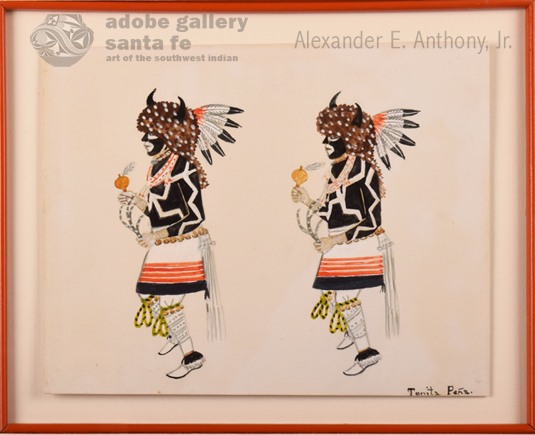Pair of Early Paintings of Pueblo Buffalo Dancers [SOLD]
+ Add to my watchlist Forward to Friend
- Category: Paintings
- Origin: San Ildefonso Pueblo, Po-woh-ge-oweenge
- Medium: watercolor
PRICE IS FOR THE PAIR - Size:
5-½” x 6-⅞” each image;
12-⅝” x 14-⅛” each framed
PRICE IS FOR THE PAIR - Item # C4182A SOLD

San Ildefonso Pueblo painter Tonita Vigil Peña (1893-1949) Quah Ah did not have an easy life. She lost her mother and sister when she was 12 years old. Her father then sent her from San Ildefonso, her native pueblo, to live with an aunt and uncle at Cochiti Pueblo, so she essentially lost her father at that time as well. She had to learn new customs, dances, songs and even a new language-Keres was spoken at Cochiti, rather than her native Tewa language. In 1908-at just 15 years old- Peña married Juan Rosario Chavez, who was 20 years old. Chavez passed away three years after their marriage. She married Felipe Herrera in 1913. He died in a work accident in 1920. Her third husband, Epitacio Arquero, outlived Tonita by a few years. They had a loving marriage and produced five children. As Tonita's children got older, they assumed the responsibility of taking care of each other, allowing Tonita more time to pursue painting. She went on to teach painting classes at the Santa Fe Indian School and the Albuquerque Indian School. Today, she is regarded as one of the most significant early Pueblo painters.
Dorothy Dunn stated “Quah Ah’s art is an art of radiance and tranquility. It is possessed of delicacy and grace, and much music. It is unequalled at conveying the dignity, the serenity, the great earnestness and wholehearted sincerity of the Pueblo ceremonial and the Pueblo people. Quah Ah’s work is not ever spectacular or striking, but it is completely unpretentious and authentic. She might be called a conservative painter for she has set her own standards in keeping with tradition and has adhered to them through the years so consistently that, even beyond her death, she has never been superseded as the dean of Indian women painters."
![]() Peña signed her paintings with varying signatures during her long career. It appears that her earlier paintings were signed with her baptismal or Christian name, Tonita Peña. She then chose to use her Tewa name, Quah Ah. As mentioned above, Tonita married Felipe Herrera in 1913 and, shortly afterwards, modified her signature to “Quah AH,” capitalizing the H in honor of Felipe. This signature lasted until Felipe passed away in 1920. After Tonita married her third husband in 1921, she changed her signature to “Quah Ah” or “QuaH AH” over “Tonita P. Arquero,” a signature that she used until 1923. In the early 1930s Tonita began using small combinations of cloud, rain, and storm motifs in conjunction with her name or names, sometimes using the names with the motifs. These became more intricate and complicated in design as time went on, and were used until her death. Remarkably, Tonita never repeated the same design, but always used a different combination on each painting.
Peña signed her paintings with varying signatures during her long career. It appears that her earlier paintings were signed with her baptismal or Christian name, Tonita Peña. She then chose to use her Tewa name, Quah Ah. As mentioned above, Tonita married Felipe Herrera in 1913 and, shortly afterwards, modified her signature to “Quah AH,” capitalizing the H in honor of Felipe. This signature lasted until Felipe passed away in 1920. After Tonita married her third husband in 1921, she changed her signature to “Quah Ah” or “QuaH AH” over “Tonita P. Arquero,” a signature that she used until 1923. In the early 1930s Tonita began using small combinations of cloud, rain, and storm motifs in conjunction with her name or names, sometimes using the names with the motifs. These became more intricate and complicated in design as time went on, and were used until her death. Remarkably, Tonita never repeated the same design, but always used a different combination on each painting.
Each of the paintings that comprise this pair is signed “Tonita Peña,” which allows us to identify them as early works. Peña’s subjects here are Buffalo Dance participants—two males and two females. Her male dancers wear spotted horned headdresses, dance kilts and leggings, and carry rattles. Her female dancers wear traditional Pueblo dresses, feathered headpieces, and white moccasins. Her compositions here are loose but strong, reminding the viewer that, even early in her career, Peña was a tremendously talented painter. Her dancers are pictured in pairs—the two males on one small painting, and the two females on one identically sized painting. Each painting is mounted with its edges exposed, surrounded by a wide off-white mat with a thin red border, within a simple wood frame. Together, they create an excellent presentation.
Condition: very good condition
Provenance: this Pair of Early Paintings of Pueblo Buffalo Dancers is from a private collection
Recommended Reading: American Indian Painting of the Southwest and Plains Areas by Dorothy Dunn
- Category: Paintings
- Origin: San Ildefonso Pueblo, Po-woh-ge-oweenge
- Medium: watercolor
PRICE IS FOR THE PAIR - Size:
5-½” x 6-⅞” each image;
12-⅝” x 14-⅛” each framed
PRICE IS FOR THE PAIR - Item # C4182A SOLD



